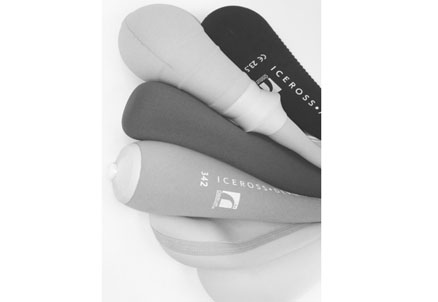Prosthetic Liners & Sleeves
Liners are designed to protect the skin of the residual limb against friction and reduce pressure on the prosthetic bone, and have special properties to work with different suspension systems.
Liner materials are available in a variety of materials such as thermoplastic elastomer, polyurethane and silicone. Every material has its own unique properties as well as its drawbacks.
Liners are available in a wide range of suspensions. A suspension is one which holds the amputee's residual limb to the prosthesis. Common suspension systems consist of a pin, vacuum, suction, contact or sleeve as well as seal systems.

Silicone coating provides high stability and grip when there is a lot of soft tissue in the limb. It works best with a locking mechanism. Soft but pressure resistant silicone is durable and easy to clean. Manufacturers recommend silicone liners for all activity levels.
Polyurethane has a unique ability to flow away from high pressure. This means that there is well distributed and even pressure in your socket. Polyurethane coating (sometimes abbreviated PUR) ensures a precise, intimate and comfortable fit for all types of residual limbs. These "flow" properties and pressure relief make it a good choice for sensitive, bony or scarred residual limbs. Polyurethane works best with vacuum or suction suspension. Both require a Total Surface Weight Bearing (TSWB). Prosthetic manufacturers recommend polyurethane for people with low to very high performance.
Copolymer is soft, emollient and very elastic, providing good protection for amputees with sensitive skin and/or work ability. In general, thermoplastic elastomers containing skin-friendly white oil are especially suitable for members with dry skin. Copolymer works best with needle or vacuum injection. Both require TSWB (total Surface Weight Bearing) fit. Manufacturers recommend copolymer coatings for people with low to moderate activity.
Medical Grade Mineral Oil Gel unlike silicone, moves with the skin and does not pull or irritate the remaining limb. The gel releases mineral oils containing moisturizing agents that help reduce scar tissue and improve the overall condition of the skin. Prosthetic manufacturers recommend mineral oil coatings for low-activity amputees.
Some prosthesis have unique features such as antibacterial and anti-wrinkle additives, textile covers for easy application, anatomical design, non-adhesive treatment, different thicknesses for sensitive skin, pre-bent knees, and also tear and puncture resistant formulas.















